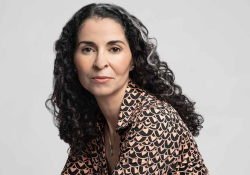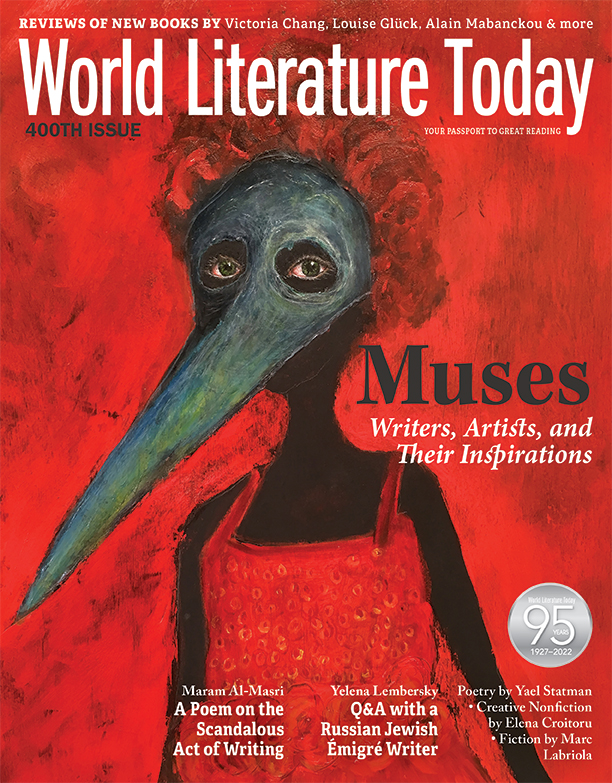Chinese and City Aesthetics: A Conversation with Jennifer Wong

Jennifer Wong is a poet, critic, and translator based in the UK. Her first two poetry collections, Summer Cicadas (2006) and Goldfish (2013), were published by Chameleon Press in Hong Kong, where she was born and raised. Her latest collection, Letters Home (2020), published by Nine Arches Press, has been named a Wild Card Choice by Poetry Book Society and includes poems from her pamphlet Diary of a Miu Miu Sales Girl (Bitter Melon, 2019). She studied English at Oxford and earned a PhD in creative writing at Oxford Brookes. In 2022 she is a visiting TORCH fellow at Oxford.
Here she discusses her poetry, her wide-ranging interest in the visual arts and aesthetics, her understanding of the agency of art, and the notion of ekphrasis, now used to refer to literary descriptions of visual artworks.
Antony Huen: On your website, you call yourself “a writer and translator.” Goldfish includes a group of poems that are translations of ancient Chinese poems. The poem “Painting,” for example, is a translation of Liu Zongyuan’s poem “Jiang Xue” (literally, “river’s snow”) and evokes the notion of “three perfections,” which describes the Chinese interconnection of poetry, calligraphy, and painting. Your image of a man “seen on a lonely boat, fishing” also reminds me of the cover artwork of Letters Home. Do you always have an interest in Chinese art and aesthetics?
Jennifer Wong: Like many other Chinese students, I grew up learning some of the ancient Chinese poems, including the ones I added to Goldfish. I love the clarity in the imagery and sound of these ancient poems. I picked the ones that speak most to me about landscapes, selfhood, and making art. I am largely a self-taught translator, and I see them as an approximation of the poems I learned, but I hope that by including them, the reader can get closer to these poems in the Chinese canon and how that must have affected my poetic sensibility.
Huen: In Goldfish, the poem “Calligraphy” looks at Chinese characters as ideograms (“four sturdy strokes stand / for the gallops of horses”). In Letters Home, Chinese characters are embedded in many poems. Poets like Sarah Howe and Mary Jean Chan have also written about and included Chinese characters in their books. How do you think anglophone readers will respond to the Chinese characters and the writing about them?
Wong: What’s fascinating about writing or engaging with multilingualism is the sheer space and possibilities. I love the way Howe and Chan play with the language(s), and I think those experiments are so much part of their poems. Chinese characters are symbols, they are monosyllabic, and they also ask to be read out loud. And there are so many different layers of meanings depending on the context you put them in. My mom used to teach me about the multiple meanings of these pictorial characters. I love the fluidity and openness of the [Chinese] language, the way so much meaning is packed into those strokes, and want to share with the reader that openness about language. Nowadays, anglophone readers are actually becoming more and more receptive to multilingual expressions, not just Chinese but Spanish, French, Korean . . . too.
In blending Chinese characters and Chinese spoken dialects—Mandarin and Cantonese—in the text of Letters Home, I encourage readers to respond to the poetic narrative by translating it in their own ways. Personally, I am excited that the world is becoming much less Eurocentric, and that readers’ curiosity and willingness to engage with the multilingual space embodies a new tradition and a new understanding about the polycentric world: we define and decode meanings via our own cultural consciousness, not someone else’s or some other nation’s. I also recall that some of your own poems, like “Cantonese Proverbs,” play with the Cantonese language, actively involving the reader in unraveling what’s in a dialect or language.
I am excited that the world is becoming much less Eurocentric.
Huen: In an essay for Wasafiri, you reported that the Chinese participants in a workshop you ran during your residency had used the Chinese words as triggers for “personal memories or encounters” or “focused on the visual shapes of a character, as if they were paintings.” This reminds me of your poem “King of Kowloon” from Letters Home, which is voiced by the viewers of Tsang Tsou-choi’s street graffiti in Hong Kong, saying that his “furious characters on the red pillar box / kindle in us an identity we have always known.” Are you always fascinated by Chinese characters and calligraphy (in whichever form)? What do you think about poetry, the visual arts, and art in general as agent(s) of political and/or sociocultural change?
Wong: In that particular poem, the graffiti is more like a language of resistance and demands to be noticed. I feel that there’s a lot of pent-up dissatisfaction or protest in Tsang Tsou-choi’s graffiti. He has been repeatedly arrested by the police, but he still keeps on painting or spraying his messages. I don’t particularly know if that’s why he wrote or what he tried to do with the graffiti, but I feel that it is a sign of something. I interpreted his act as a sign of what the locals are hoping to do, but they are always afraid of showing what they actually think or feel. I realize that it is very important for poetry to capture the “truth,” and truth may appear in different forms or be understood differently. I think poetry inevitably reflects people’s understanding of the world around them.
Poetry inevitably reflects people’s understanding of the world around them.
 Huen: You were commissioned by the Tate to write in response to John Sargent’s art. You have also written about Zhang Xiaogang’s paintings in Goldfish and Letters Home. All these poems are centered on human subjects. Are you drawn to portraits more than other types of paintings? Would your approach to a painting be different when it was a commissioned project?
Huen: You were commissioned by the Tate to write in response to John Sargent’s art. You have also written about Zhang Xiaogang’s paintings in Goldfish and Letters Home. All these poems are centered on human subjects. Are you drawn to portraits more than other types of paintings? Would your approach to a painting be different when it was a commissioned project?
Wong: I think yes. I’ve always been very interested in people and people’s stories. I used to tease my husband because he likes going on a beach holiday, preferably a quiet beach with no one around, whereas I’d love to be in places where I can see other people walk about.
When it is a commissioned piece, you get a specific topic set down for you, and you will learn to love it over time. I was working as an intern at Tate at that time, and they asked, “Why don’t you curate a set of poems for the art collection?” Of course, I’d love to! And I walked around the gallery and landed on this Sargent painting, which I have always loved. When I read up on the way the painting was done and how much the artist strived to capture that perfect light, I was just amazed, and I feel that’s really what art is about.
Huen: In Goldfish, you also express interest in sculpture and architecture. You have called attention to the artist in the title of a poem, as in “Orozco’s Bike,” and through an epigraph (the poem “Gift” begins with an epigraph from Yayoi Kusama: “At one time, I dreaded everything I was making”). These poems refer not only to the sculptures but to the artists and their making of art. What was the background of your ekphrasis in these three poems? What does ekphrasis mean to you?
Wong: After I had finished my creative writing MA in Norwich, I moved to London for the summer, and since then I did a few brief internships at Tate Britain and Tate Media, where I got to spend some amazing time with the people working there. It’s inspirational to move in the gallery space, thinking that everything—the paintings on the walls, the sculptures, the gallery spaces and lighting, and the curatorial text—is all “work,” so many artists’ work. So that’s why I have included some of my reflections on the artists’ work in my poems, too. And you’re right, there’s a sense of admiration and anxiety about art that I wanted to share, which feels at times untranslatable. I feel that there is a Yayoi Kusama in many of us, that latent energy about to surface. And I had fun playing with those images in my head, especially “Orozco’s Bike,” because I added Hong Kong to his map!
And ekphrasis is a fantastic way of getting into poetry, a way of embodiment and distillation.
Huen: In an interview elsewhere, you told us that you “first fell in love with English poetry” in high school, “reading poems by Sylvia Plath, Philip Larkin, Carol Ann Duffy,” who have all contributed to the modern ekphrastic tradition. Do you see yourself working within that tradition? And what about the influence of those with Chinese heritage, including Li-Young Lee and Hannah Lowe, whom you interviewed for World Literature Today?
Wong: I don’t overthink if I’m working in one tradition or the other. I think one thing I realized is that we are all influenced by each other in some ways, and that we are readers as much as writers. One thing, though, is that when I was a student in Hong Kong, most of the poets I studied were from the US and the UK. I didn’t have the awareness that I, too, or we too, can write in English.
Huen: The use of Lam Tung Pang’s artwork on the cover of Letters Home marks your second “collaboration” with the Hong Kong–based artist. Back in 2015, you were invited by Lam to write in response to his site-specific art. How has this creative or co-creative relationship developed all these years?
Wong: I love the epic scale and sheer energy in Tung Pang’s work. I think I approached him to explore collaboration after coming across his artwork in the digital space. When I went to Hong Kong, we met up, too, and he showed me his studio, where I could see the actual paintings that I was to respond to in my poetry. He’s not just a great artist but generous in giving to the community, generous with advice for other artists. I enjoyed being able to attend and read poems in his gallery exhibition Saan Dung Gei at Blindspot Gallery at the end of 2018. I remember writing about the exhibits and then, on the day I saw the model train running in the background, going through the tunnel. It felt as if we were all in his paintings.
I love the epic scale and sheer energy in Tung Pang’s work.
Huen: Recently, you have been involved in projects with digital components. Your poem “Houhai” (referring to a lake in Beijing) was published on the website of Wasafiri with two photographs preceding it and a video recording of your reading. The photograph of a Chinese garden with a bridge complicates our understanding of this line: “And the photo we took at Silver Ingot Bridge.” We both contributed to HK-SG Digital Travel Bubble, and your photographs of an urban district of Hong Kong and poems are driven by your attachment to cities, the objects from them, and the associated memories and visual images, which include “Coleman’s map in 1835” and “the films you watch.” What does the age of digital reproduction mean to you as a writer?
Wong: That’s such an interesting question, and I suppose we all encounter and adapt to the digital, the idea of digital reproduction, as writers, and feel excited by it. On a day-to-day basis, digital reproduction or photo-taking has become so much a part of our lives. It is as if we made the reality more real by taking digital pictures. But in part my poem “Houhai” is to contest the way digital reproduction replaces the need to actually be somewhere, to see it that moment, to dwell in that moment. Because I was there in Houhai, once, and I want to somehow translate that sense of permanence of place, while at the same time I cannot fully grasp it, too, even though I was there once, because it is changing and it will keep on changing.
Huen: You have written many poems about movies, including those directed by Wong Kar-wai. In my review of Letters Home, I suggested that your epic poem “Mountain City” draws on the art of painting and cinematography by “painting Hong Kong in red” and functioning like a filmic documentary about the city’s society and culture. Have you ever seen yourself as a writer making movies in your poetry?
Wong: I’ve always enjoyed visual art and films. I just can’t help falling in love with the moving image, and to a certain extent, poetry has always been able to do that, because you start and finish the poem in different places, the way you do in watching a movie or visiting a place.
Huen: Speaking of Goldfish, the poet Tamar Yoseloff said, “Wong records the colour and detail of the world around her with great precision and delicacy.” Do you see yourself as a poet with an acute visual sense? Do you actively draw your inspiration from the visual arts?
Wong: I go to galleries quite often, especially before the pandemic. I love the works by Bridget Riley, Agnes Martin. I love the sculptures of Barbara Hepworth, etc. Seeing the diverse works in art shows always excites me. For me, good poetry or literature can move us and change us in ways that other art forms cannot do so easily. I’d like to explore more what one can convey with precision and what that can’t be: the messy, chaotic feelings we have sometimes.
February 2022
Read “King of Kowloon,” a poem by Jennifer Wong from this same issue.

Born and raised in Hong Kong, Jennifer Wong studied English at Oxford University and has a creative writing PhD from Oxford Brookes University. She is the author of Goldfish (2013) and teaches part-time at City Lit and Oxford Brookes.











